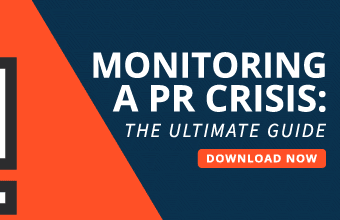The emergence of generative AI tools such as ChatGPT has taken the world by storm. Despite being a relatively new industry, the generative AI market is projected to be worth $126 billion by 2030.
The ability of generative AI tools to understand human language, analyze vast amounts of data and generate human-like responses presents immense opportunities for businesses, particularly when it comes to communicating with their audience. Projections show that by 2025, nearly a third of messages from large brands will be AI-generated. In comparison, less than 2% of messages were AI-generated in 2022.
Generative AI is especially useful to public relations professionals, who are required to constantly monitor public sentiment about their brands and swiftly respond to anything that could damage the brand’s reputation.
In this article, we’ll dive into the world of generative AI and explore how PR professionals can leverage this emerging technology for effective and efficient crisis communication.
What is generative AI?
Generative AI is a branch of artificial intelligence that aims to mimic human-like creativity and problem-solving abilities. It’s referred to as generative because it focuses on generating new, original content, such as text, images, video, and audio. It does this by analyzing large datasets it’s been trained with and understanding the relationships and patterns in this data. OpenAI’s ChatGPT is an excellent example of a generative AI tool.
The ability to create original content makes generative AI useful in a wide range of applications, including creative writing, automated chatbots, virtual assistance, recommendation systems, and even crisis communication.
The role of generative AI in crisis communication
Generative AI can be a valuable tool for companies to improve crisis communication by enhancing various aspects of their response. Here are some ways in which companies can utilize generative AI:
#1 Real-time automated alerts
The ability to analyze large volumes of data and apply natural language processing techniques makes generative AI the perfect tool for continuously monitoring various sources of information. Generative AI tools can keep track of different social media platforms, public forums, news articles, and other news sources to detect potential crises in near real-time and provide alerts to PR professionals.
These real-time alerts significantly reduce the time it takes for PR professionals to become aware of a looming crisis and allows them to take proactive measures to respond to the crisis before it gets out of hand.
#2 Drafting rapid response messages
The best way to manage a PR crisis is to provide prompt and effective communication that addresses public concerns, provides updates, and shows the brand’s commitment to resolving the situation. Since generative AI is capable of producing human-level messages in seconds, it can play a valuable role in helping PR teams swiftly draft response messages.
For this to work, you need to train AI models on past crisis communication messages, key messaging guidelines, and your preferred tone. With this data, AI can generate initial statement drafts, social media posts, and press releases that your PR team can use as a starting point, cutting the time it takes to address the public.
#3 Multilingual crisis communication
For companies that operate in multiple regions, some crises can easily have a global impact. To effectively manage such crises, you need effective communication across multiple languages to ensure that audiences in different regions receive accurate information. The problem is you might not have a translator on standby.
Generative AI provides a solution in such situations by using machine language translation techniques to quickly and accurately translate your message into multiple languages. This allows you to reach a wider audience without the risk of misinterpretation or misunderstanding due to inaccurate translations.
#4 Social media sentiment analysis
During a crisis, a lot of public discourse about your brand happens on social media platforms. However, keeping track of conversations across multiple channels can be challenging, especially when time isn’t on your side. With Generative AI models, you can implement social listening, analyze the sentiment of social media conversations and quickly identify emerging issues related to the crisis.
These AI tools go through large volumes of social media data in real-time and identify patterns that show how the public perceives the crisis. You can then use this information to pinpoint areas of concern or misinformation you need to address and adapt your PR strategy accordingly.
#5 Dynamic adaptation of PR strategies
Crisis communication often involves addressing the public across multiple channels and platforms. However, each platform has its unique characteristics, tone, and communication style. A message that works on one platform can get misconstrued on another channel.
Generative AI allows you to quickly adapt your message to suit different platforms for maximum engagement. For instance, from the same draft response, generative AI can come up with short and attention-grabbing captions for your social media posts and a more formal and detailed statement for a press release. This adaptability ensures that your message reaches its intended target most effectively.
#6 Chatbot support
During a crisis, it’s very likely that your company will experience a surge in inquiries and requests for information. However, keeping these people in the queue as your support agents try to respond to everyone manually only worsens the situation.
A better approach is to use AI-powered chatbots to respond and provide immediate assistance to concerned individuals. Once you train the chatbot with crisis-related data, approved responses, and detailed information about your company and products, the chatbot can provide more personalized and context-specific responses. Responding to inquiries promptly and providing relevant and accurate information quickly can go a long way in managing the crisis and restoring customers’ trust in your company.
#7 Crisis simulation and training
Companies that effectively manage their communications in times of crisis don’t rely on spur-of-the-moment reactions. They prepare for the crisis in advance, so they already know what to do when it does occur. Generative AI can assist in this regard by helping companies to simulate different crisis scenarios that they can use to train their PR teams.
Generative AI models can generate realistic crises for your team to practice by analyzing historical data, potential risk factors, industry-specific knowledge, and any key performance indicators (KPIs) your company has been tracking. A KPI is simply a quantifiable metric used to track progress towards specific goals so organizations can make more data-driven decisions, and is therefore vital for your AI model to analyze.
Generative AI can also test the effectiveness of your crisis communication strategies and provide recommendations for improvement.
#8 Video and multimedia content generation
Visual content such as graphics, videos, and infographics is often very effective for passing information and engaging your audience during a crisis. However, producing visual content usually takes time. Fortunately, generative AI models can help shorten the production time by automating various aspects of the content creation process.
For example, you can use generative AI to create video scripts, captions, and subtitles when creating video content. You can also use AI models to generate informative graphics, charts, and visual data representations. This allows you to produce high-quality video content faster, ensuring that crucial information related to the crisis reaches your audience promptly.
Wrapping up
Generative AI tools offer undeniable benefits in crisis communication. They allow brands and organizations to give swift and effective responses in times of crisis, ensuring public concerns are addressed in a timely manner.
Leveraging generative AI for crisis communication also ensures consistent and accurate messaging across platforms and enhanced stakeholder engagement and satisfaction while providing a cost-effective solution for crisis communication. The technology also allows organizations to be better prepared for crises by providing automated alerts and opportunities for crisis simulation and training.
By embracing this technology, companies of all sizes can navigate crises with agility, maintain their reputation, and build stronger relationships with their customers and other stakeholders.








